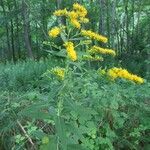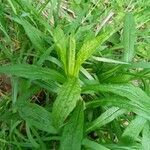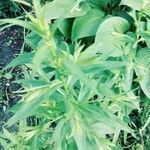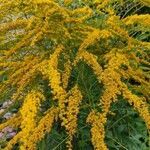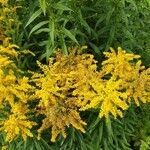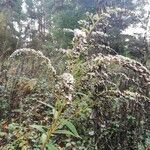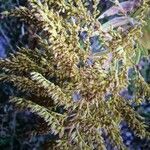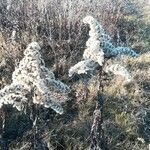Plants 30-150(-200) cm; rhizomes short to long creeping. Stems 1-20+, erect, glabrate proximally or sparsely strigoso-villous, becoming more densely so distal to mid stem. Leaves: basal 0; proximal to mid cauline usually withering by flowering, tapering to sessile bases, blades narrowly ovate-lanceolate, 50-190 x 5-30 mm, margins sharply serrate, 3-nerved, apices acuminate, abaxial faces glabrous or more commonly hairy along main nerves, adaxial glabrous or slightly scabrous; mid to distal similar, 30-50(-120) x 8-12 mm, largest near mid stem, reduced distally, margins usually serrate or serrulate (teeth 3-8), sometimes entire proximal to arrays. Heads (70-)150-1300+, secund, in secund pyramidal-paniculiform arrays (obscurely so and club-shaped thyrsiform in small plants or shoots with small arrays), branches divergent and recurved, branches and peduncles hairy. Peduncles 3-3.4 mm, bracteoles 0-3, linear-triangular. Involucres narrowly campanulate, 1.7-2.5(-3) mm. Phyllaries in 3-4 series, strongly unequal, acute to obtuse; outer lanceolate, inner linear-lanceolate. Ray florets (5-)8-14(-18); laminae 0.5-1.5 x 0.15-0.3(-0.5) mm. Disc florets (2-)3-6(-8); corollas 2.2-2.8(-3) mm, lobes 0.4-0.8(-1) mm. Cypselae (narrowly obconic) 1-1.5 mm (ribbed), sparsely strigose; pappi 1.8-2.2 mm.
Perennial, stoloniferous herb forming dense patches; stems erect, green or tinged reddish, moderately clothed in short hairs, becoming almost glabrous toward base, not branched, up to 2 m tall. Basal lvs withered at flowering; mid cauline lvs narrow-elliptic to elliptic-lanceolate, apetiolate, cuneate, acute to acuminate, usually entire, sometimes serrate, 3-nerved, scaberulous on upper surface and margins, pilose on lower, 8-10-(15) × 1-2-(2.5) cm; uppermost lvs smaller. Infl. a lax, racemose panicle with the individual racemes mostly spreading and secund. Capitula cylindric, (2)-3.5-5 mm diam.; peduncles hairy, 0.5-2 mm long. Inner involucral bracts narrow-oblong, glabrous, (2.5)-3-3.5 mm long; outer bracts narrow-triangular, c. 1.5 mm long. Ray florets c. 8-12; ligules linear-obovate, yellow, 1-3 mm long, recurved. Disc florets 3-5-(6), yellow. Ovary hairy; pappus scabrid; mature achenes not seen.
Perennial, mostly with long, creeping rhizomes (rhizome short in var. gilvocanescens), 2.5–20 dm, the stem ± puberulent at least above the middle; lvs chiefly cauline, numerous, triple-nerved, lance-linear to lance-elliptic or narrowly elliptic, sessile, tapering to both ends, the larger ones 3–15 cm × 5–22 mm, puberulent at least on the midrib and main veins beneath; infl mostly paniculiform, with strongly recurved-secund branches (varying to thyrsoid and not secund in var. salebrosa); invol 2–4(–5) mm, its bracts imbricate, thin and slender, acute or acuminate, yellowish, without a well defined green tip; rays 10–17 (or fewer in var. hargeri), 1–3 mm; disk-fls 2–8 (to 13 in var. salebrosa); achenes short-hairy; 2n=18, 36, 54. Moist or dry open places and thin woods; throughout most of the U.S. and s. Can. Five vars. in our range:
Herbs, perennial; rhizomes creeping, branched. Stems to 150 cm tall, erect, simple, shortly and softly downy above. Leaves numerous, lanceolate or linear-lanceolate, 5-12 cm, abaxially downy, veins sparsely hairy, adaxially shortly pilose, tapering at both ends, margin of basal sometimes entire, of lower and upper cauline sharply serrate, longitudinal veins 3 (triplinerved), of which 2 lateral veins protrude weakly, apex acuminate. Capitula in paniculiform synflorescences, branches (racemes) curved downward, capitula attached on upper side of branch. Involucre 2.5-3 mm; phyllaries linear-lanceolate, slightly obtuse. Florets golden yellow; ray florets hardly longer than involucre. Pappus inner (longest) bristles not obviously clavate. Fl. Aug-Sep.
A herb which keeps growing from year to year. It has underground stems or rhizomes and also runners or stolons. The stems are erect. They grow 1.5 m high. The leaves are alternate and simple. They are 10 cm long. They do not have stalks. The leaves have teeth along the edges. The flower head is open and branched. The heads are in line on one side of the branching head. The flowers are yellow.

